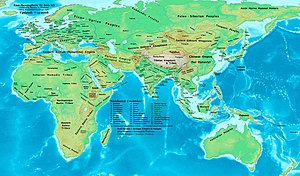Khanate
Khanato or khanate is a word of Turkic-Mongolic origin used to describe a political entity ruled by a khan. In modern Turkish, the word used is kağanlık, and in modern Azerbaijani from the Republic of Azerbaijan, xanlıq. In Mongolia the word khanlig is used, as in Khereidiin Khanlig, which means Kerait Khanate.
This polity is typical of the Eurasian steppe peoples and may be equivalent to other tribal terms such as chiefdom, principality, or kingdom.
The khanates were regrouped into kaganatos, a kind of empire under the authority of a sovereign khan, kan of khans, known in Spanish as Great Khan or kagán (Turkish: kağan; Mongolian: хаган; Chinese: 可汗; pinyin, kehán).
Examples of Kaganates and Khanates
Pre-Mongol Turkic Kaganates
- Kaganato de los Köktürks (552-744);
- Western Turkic Kaganato (593-659);
- Kaganato of the Eastern Avars
- Kaganato uigur (742-848);
- Kaganato Kara-Khanid (840-1212);
- Kaganato de los Jázaros (sixteenth centuryVI- centuryXI).
Mongol Khanates
When Genghis Khan died, he divided his empire into four sections for each of his sons and grandsons. After Mongke Khan's death in 1259, the succession war, essentially between Kublai Khan and Ariq Boke, marked the end of the unified empire and the emergence of four independent khanates, or ulus (Mongolian: uls, which means country or region).
These khanates were:
- the Chagatai kanato, which included Central Asia, the headquarters of the Djaghataïdes;
- the kanato of Kipchak, in the Russian steppes and in Kazakhstan, headquarters of the Golden Horde;
- the IlkanatoRegional), covered a large part of the Near East, domain of houlagides or ilkhans;
- China of the Yuan dynasty, which encompassed Mongolian kanato.
Post-Mongol Khanates
Subsequently, smaller khanates were formed after the disintegration of the four ulus:
- In the ancient Kipchak kanato the local kanatos appeared:
- Kazan kanato (the Mongol term, used from the Gengisida dynasty, was settled in the Kazan duke in 1430; the imperial Russia added to its titles the old Kazan kanato with the royal style of tsar;
- Kanato de Siberia (in Western Siberia), who gave his name to Siberia as the first major conquest in the great eastern expansion of Russia through the mountain range of Urals, conquest undertaken by Ivan the Terrible and his successors between 1552 and 1600;
- Kanato de Astracán;
- kanato of Crimea, which will be linked to Russia by Catherine the Great in 1783.
- Three Uzbek kanatos were established in the former Chagatai kanato:
- Bukhara, who also included Samarkand, linked to the Soviet Union in 1920;
- Jiva, linked to the Soviet Union in 1920;
- Kokand, linked to Russia in 1876.
- Kanato Khoshut
Examples of other khanates of more humble Tatar dynasties, which became vassal states of Muscovy and Russia were:
- the kanato of Qasim (in modern Kasimov), named by its founder, a vassal state of Moscovia/Russia;
- the nomadic state founded in 1801 as the Horda Interior (also called Horda Buqei, under Russian sovereignty) between the Volga and Yaik rivers (Urales), of 5000 Kazakh families of the Zhuz tribe of Young Kazajos, commanded by a sultan, was reformed by it in 1812 as a kanato of the Inner Horde; in 1845, the position of Khan was abolished);
- the kanato of Kalmyk (established ca. 1632 by the Torghut branch of the Mongols of Oirats; settled in the lower part of the Volga river (in the present Russia and Kazakhstan);
- of Nogai (1440-1634);
- the kanato of Tuvá, near Mongolia;
- the Kathana of Baku in present-day Azerbaijan;
- Besh Tau El.
Farther east, on the western flank of Imperial Chinese Turkestan:
- Dörben Oyriad ('Cuatro Confederados') or kanato Dzungar (successful villages) formed in 1626, covering the Chinese region of Sinkiang, Kyrgyzstan, East Kazakhstan and Western Mongolia; on 2 December 1717-20 also in the protective style of Tibet; 1755 in China; annexed in 1756 and dissolved in 1757;
- Kanato de Kasgar founded in 1514 as part of the kanato of Djagataide; in the centuryXVII was divided into several minor kanatos without importance, with real power in the so-called Khwaja, Islamic Arab religious leaders; the title changed Amir Kan in 1873, annexed by China in 1877.
- Kanato de Kumul, vassal state of the Qing dynasty and the Republic of China, abolished in 1930.
Khanates of the Caucasus in the Qajar Empire (18th to early 19th century)
- Kanato de Baku
- Kanato de Ganja
- Kanato de Quba
- Kanato de Derbend
- Kanato de Shaki
- Kanato of Yerevan
- Kanato de Karabaj
- Kanato de Javad
- Kanato de Lankaran
- Kanato de Shirvan
Khanates in Iran from the Qajar period[citation needed]
- Kanato de Urmiyya
- Kanato de Khoy
- Kanato de Maku
- Kanato de Karadagh
- Kanato de Tabriz
- Kanato de Maragha
- Kanato de Ardabil
- Kanato de Sarab
- Bushehr Kanate
- Kanato de Khorasan
Contenido relacionado
Anna Lindh
Intifada
Francisco Fruits
